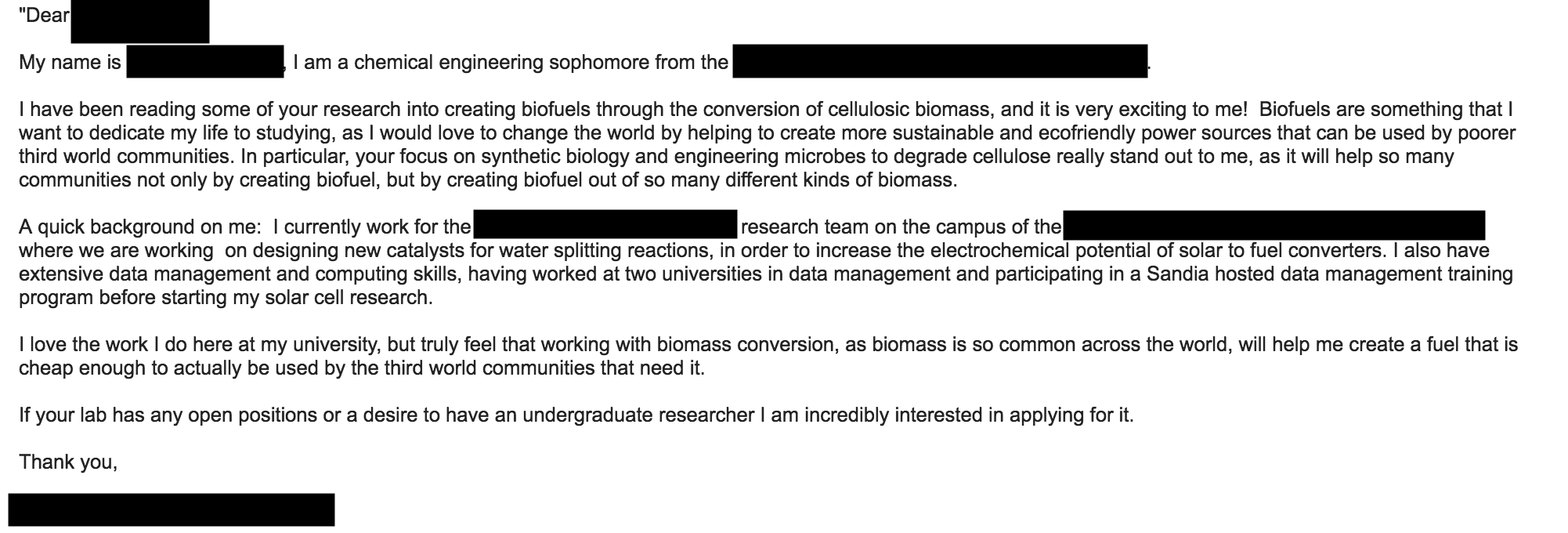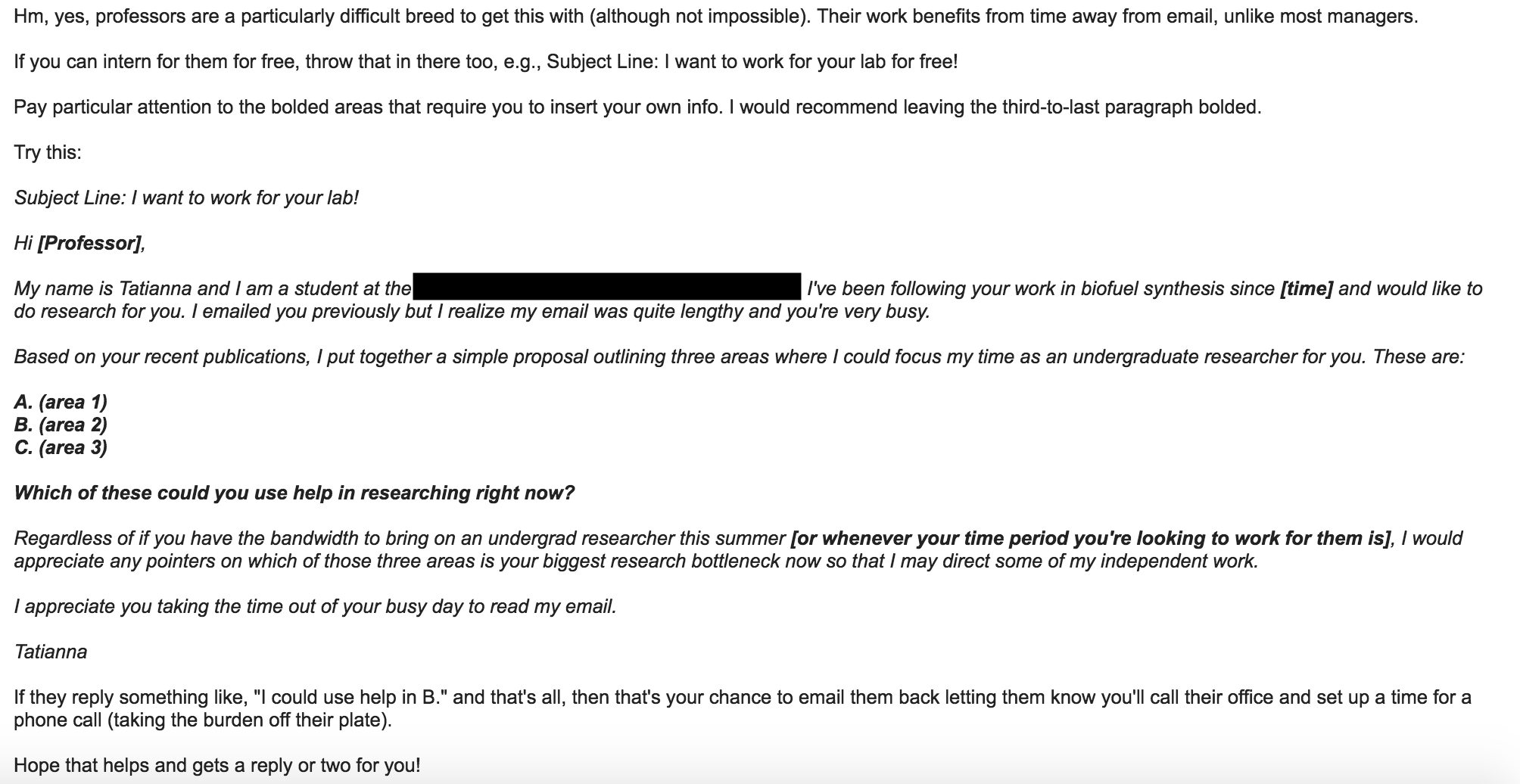Last night, while burning the midnight oil, a question rolled in from a new subscriber looking to use my 12 Done-For-You Email Scripts to get a research internship at the California Research Institute of Algae. With her permission, I wanted to share my feedback and what makes emailing professors different than emailing most managers.
Her initial email to me was actually pretty good. She sent it as a reply to my Mailchimp final confirmation email. It captured my attention at midnight and made it very easy for me to reply.
Dear Mr Slayback,
I my name is Tatianna and I am a Chemical engineering sophomore.I am dead set on working for the California Institute of Algae research, do you think your interview email will work for this?Thank you,Tatianna
The core of my networking philosophy comes down to this: know the incentives of the person you’re trying to talk to.
Most businesspeople have pretty easy to see incentives. At the end of the day, they want to grow their business (whatever that means for their industry and specific role), hire great talent, and delegate urgent-but-not-important tasks to that talent. They also want to avoid losing money, adding unnecessary tasks to their to-do lists, and looking bad in front of stakeholders. Help them do the things they want and avoid the things they don’t want and you can get your foot in the door. And don’t make the email hard to read (i.e., long, prose-like text).
Short emails that make it clear you did your research and respect their time work well. The script in my ebook is almost too long but performs well because it establishes rapport, relevance, and responsibility in the first few sentences.
“How should I email professors?”
Professors, who run the lab Tatianna wants to work for, are a little different than most managers. They still have an incentive structure, and that is to do quality research that helps them raise money from donors, grant-making organizations, and the government.
Personally, they are also Very Busy People whose work benefits from long stretches away from their email inbox doing research and working in the lab. This is why research professors are often difficult to communicate with via email – they don’t have an incentive to be efficient at email like managers in the private, for-profit sector may. Cal Newport, a research professor at Georgetown University, writes in Deep Work that he will do everything in his power to avoid administrative roles for this reason.
So, to understand their incentives, we can create an Incentive Map, showing what they want to achieve and want to avoid:
Achieve
- Produce quality research
- More time on complex research (versus simple research, see below)
Avoid
- Looking silly in front of colleagues
- Spending time on data management and simple research that can be performed by an undergraduate research assistant (e.g., sexing fruit flies comes to my mind here)
- Spending time training and managing subordinates who do not help take time away from the above
- Preparing for lectures (if also a teaching professor)
(This was actually how I got my Penn Undergraduate Research Mentorship when I was a sophomore in college. The professor under whom I studied was finishing a book and also had to prepare for an upcoming majors-only seminar. I did the research for the seminar while she finished her book.)
Any email she sends a professor with that Incentive Map should signal that working with her will create more of the Achieve and get rid of (or at least, not create more of) the Avoid.
Let’s take a look at the first email Tatianna sent along. She told me this email was not getting responses.
Email Teardown

The first thing I notice is that this email is long without a clear call to action. There’s a chunk in the middle telling me about her experience. There’s an attempt at building rapport at the beginning by complimenting the professor on her research.
When emailing Very Busy People, remember that you only get about 1 second of their attention skimming your email before they either decide “too much work, I’ll come back to it later,” or decide to ignore it outright.
If I am a professor who does not like spending time on emails and would rather be working on research, this email would not pique my interest. While well-written, it’s long and unclear.
Instead, Tatianna should approach the professor and let her know from the get-go that she wants to work for her. This is a case where a compelling subject line does go further.
I Want to Work For You! is more compelling than, Student Emailing About Research.
Try Pre-Canned Options
This was my reply:
This email does a few things:
- It makes it ridiculously easy to reply (I call this a “pre-canned response” and is a variation on Ramit Sethi’s Ramit’s Two-Punch). The professor can simply reply, “A,” and give Tatianna something to go on for furthering the conversation.
- It makes it clear from the get-go what she wants. She wants to work for the professor. We see that in the subject line and we see it in the first paragraph.
- It makes it clear she knows its her responsibility for continuing the conversation. The last paragraph shows that she’s going to do this work regardless of her status as a research assistant at this lab. My recommended follow-up (advice from Ogilvy on Advertising) gives her a clear idea of how to actually get on the phone with this professor.
16 Times of Number 9 Replies
My parting word of advice for somebody in Tatianna’s shoes would be the same as always:
Always, always, always, always follow up!
One of my business coaching clients sent me this email the other day:
What do you notice (besides that I give amazing introductions)?
“16 emails over 4 months”
It took him following up 16 times since November to land a meeting with the CTO of a major potential client. Most people give up after one, two, or maybe three follow up emails. He sent 16 emails and finally got this meeting. That could be the difference between $0 and $3000/month in new client work. And for what? Just a few minutes per day?
Always follow up until the person either tells you to stop emailing them, you land the opportunity elsewhere, or they reply.

